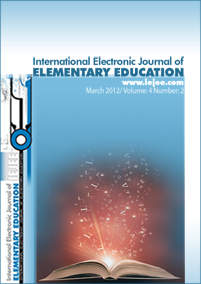Published
August 23, 2017
| Pages: 347-366 | Views: 420
Abstract
This mixed-methods study incorporated elements of survey, case study and action research
approaches in investigating an at-risk child. Using an in-take interview, a diagnostic test, an error
analysis, and a think-aloud clinical interview, the study identified the child’s major presenting
difficulties. These included: inability to use the four arithmetic operations (addition, subtraction,
multiplication, division) efficiently; not understanding the relationship between units, tens and
hundreds; using any two of the four arithmetic processes (+, - , x, ÷) in combination within one
operation; treating each column as a separate problem; place value problems / wrong alignment of
numbers; poor eye-hand coordination leading to dysgraphia; and memory lapses. The other problems
that became apparent through this investigation and implied in the findings include possible causal
factors such as dyscalculia, dyslexia, low self-esteem, low self-efficacy, and math anxiety. Further
assessment, intervention and research are recommended to address problems of this vulnerable child.
Listen -




References
Bos, C. S., & Vaughn, S. (2002). Strategies for Teaching Students with Learning and Behavioural Problems.
Boston: Allyn and Bacon.
Dettmer, P., Thurston, L. P., & Dyck, N. (2002). Consultation, Collaboration and Teamwork for Students
with Special Needs. Boston: Allyn and Bacon.
Engelbrecht, P., Green, L., Naicker, S. & Engelbrecht, L. (1999). Inclusive Education in Action in South
Africa. Pretoria: J.L. van Schaik.
Fogiel, M. (1989). The psychology problem solver. Piscataway, NJ: Research and Education Association.
Hall, R. (1994). An Introduction to Children with Special needs for Teachers in Mainstream Schools.
Wewak, PNG: Wirui Press.
Heward, E. L. (1996). Exceptional Children: An Introduction to Special Education. Englewood Cliffs:
Merrill/Prentice Hall.
Kelly, M. J. (1986). The Provision of Education for All: Towards the Implementation of Zambia’s
Educational Reforms Under Demographic and Economic Constraints. Lusaka: University of Zambia.
Kelly, M. J. (1991). Education in a Declining Economy. EDI Development Policy Case Series, Washington,
D.C.:World Bank.
Lohman, D. F. & Lakin, J. (2008). Nonverbal strategies as one component of an identification system:
Integrating ability, achievement, and teacher ratings. In J. Van Tassel-Baska (Ed.), Alternative
assessments with gifted and talented students (pp. 41-66). Waco, TX: Prufrock Press.
Martin, H. (2010). Special educational needs “over-identified”. The Psychologist, 23(11), 872-873.
Mercer, C. D. (1997). Students with Learning Disabilities. Columbus, OH: Merrill/Prentice Hall.
Mundia, L. (1996). The Status of Mathematics and Science Teachers in Papua New Guinea Provincial
High Schools: A Case Study of Selected Regions. Journal of Practice in Education for Development,
2(1), 25-29.
Mundia, L. (1998). Adapting testing strategies for learners with special educational needs in Papua
New Guinea schools. Papua New Guinea Journal of Teacher Education, 5(1), 1-5.
Mundia, L. (2010). Implementation of SPN21 curriculum in Brunei Darussalam: A review of selected
implications on school assessment reforms. International Education Studies, 3(2), 119-128.
Murray, D. (1996). Forget Charity? We have a Right to Fair Assessment: Accommodating Student with
Disabilities Need Not Compromise Assessment Standards. An unpublished paper presented at a
conference on “Partnerships on the Assessment of Student Achievement” held in Auckland, New
Zealand, September 22-28.
Olzewski-Kubilius, P. & Kulieke, M. J. (2008). Using off-level testing and assessment for gifted and
talented students. In J. Van Tassel-Baska (Ed.), Alternative assessments with gifted and talented
students (pp. 89-106). Waco, TX: Prufrock Press.
Rivera, D. M., & Bryant, B. R. (1992). Mathematics instruction for students with special needs.
Intervention in School & Clinic, 28(2), 71-86.
Salvia, J. & Ysseldyke, J. (2004). Assessment: In special and inclusive education. Boston, MA: Houghton &
Mifflin.
Somerset, H. C. A. (1987). Examination Reform: The Kenya Experience. Report No. 64. A Report Prepared
for the World Bank. Sussex: IDS.
Taylor, R. L. (2003). Assessment of Exceptional Students: Educational and Psychological Procedures.
Sydney: Pearson Education.
Thompson, R. A. (2003). Counselling Techniques. New York: Brunner-Routledge.
Thornton, C. A., Tucker, B. F., Dossey, J. A., & Bazik, E. F. (1983). Teaching Mathematics to Children with
Special Needs. Menlo Park, CA: Addison-Wesley.
Trafton, P. (1987). Assessing for learning: Tests – a tool for improving instruction. Arithmetic Teacher,
35(4), 17-18, 44.
Van Tassel-Bask, J., Quek, C., & Feng, A. (2007). Developing structured observation scales for
Instructional improvements in classrooms accommodating gifted learners. Roeper Review, 29(2),
84-92.
Venn, J. J. (2000). Assessing students with special needs. Upper Saddle River, NJ: Merril.
Keywords
Mixed Methods Research, Survey, Case Study; Action Research, Authentic Assessments;, Dyscalculia, Dyslexia, Dysgraphia
Affiliations
Lawrence Mundia
University Brunei Darussalam, Brunei
Downloads
Download data is not yet available.
